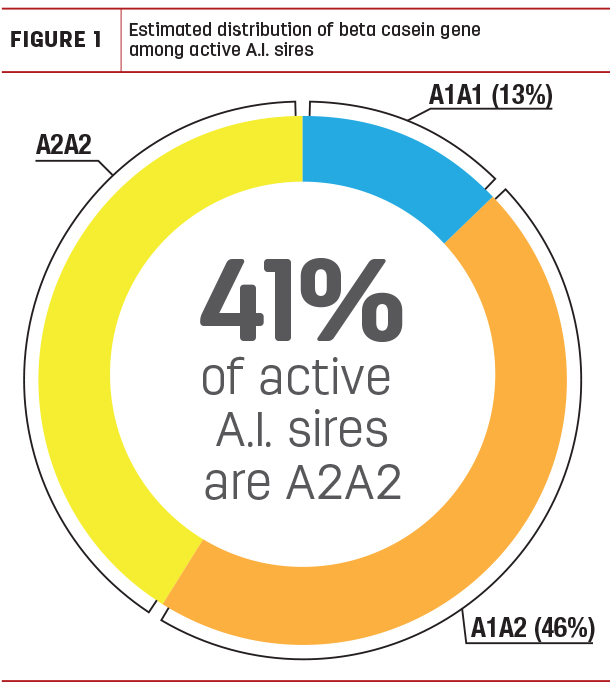Since its 2015 U.S. debut, A2 milk has been a hot topic among dairy producers. Now the latest A2 buzz comes from consumers, following the launch of the a2 Milk Company’s national television advertising campaign.
While the curiosity around A2 milk grows, it’s important to evaluate whether this is just another fad in genetic selection or a real future of the industry.
What is A2 milk?
A2 milk comes from cows with two copies of the A2 gene for beta casein. Cows’ milk is about 87 percent water and 13 percent solids. Those solids include lactose, fat, protein and minerals.
To find the A2 gene, we look to the protein in milk. Casein is what makes up the majority of milk protein, and about 30 percent of that casein is called beta casein. The two most common variants of the beta casein gene are A1 and A2, so any given bovine will be either A1A1, A1A2 or A2A2 for beta casein.
Milk from U.S. cows has traditionally contained a combination of both A1 and A2 beta casein.
Isn’t A2 milk for people with lactose intolerance?
Not necessarily. A2 milk contains the same amount of lactose as non-A2 milk. So a person who has been clinically diagnosed with lactose intolerance will see no benefits from drinking A2 milk.
Some studies have shown the A2 beta casein in milk to be more easily digestible than the A1 beta casein. This means the discomfort some people experience after drinking milk could actually be linked to an A1 aversion rather than to lactose intolerance. Since the majority of lactose intolerance cases are self-diagnosed, for those people, A2 milk could be the answer.
How do you get cows that produce A2 milk?
The only way to have a herd that produces A2 milk is through genetic selection. For a cow to produce true A2 milk, the cow must have two copies of the A2 gene in its DNA. Each animal receives one copy of the beta casein gene from its sire and one copy from its dam. So for a 100 percent chance at an A2A2 animal, you must breed an A2A2 bull to an A2A2 cow.
How do you know if your animals are A2?
The only way to know for sure is a genomic test. Some companies offer A2 genetic testing as an add-on to a full genomic test. Others offer testing for A2 on its own for as little as $15.
How long will it take to convert your herd over to only A2?
This entirely depends on how aggressive your approach is. If your goal is to immediately become 100 percent A2A2, you can make that happen. To do that, you’d need to genomic test each of your animals, keep only those verified as A2A2 and sell the rest.
A less extreme option for large, multi-site dairies is to genomic test all females and sort any animals verified as A2A2 all to one site.
But since those aren’t realistic options for most farms, another approach is to limit your sire selection to only bulls confirmed as A2A2. Most A.I. companies publish this information on their proof sheets or websites.
A rough approximation of active A.I. sires shows about 13 percent are A1A1, 46 percent are A1A2, and 41 percent are A2A2 (Figure 1).

If you figure that same proportion within your own herd, it would take seven generations of breeding your untested females strictly to A2A2 bulls before you’d reach 99 percent of A2A2 females.
What do you have to lose by selecting A2A2 sires?
With 40 percent or more of active A.I. sires verified as A2A2, you have a good number of sire options to use in your breeding program. This also means less than half of the bulls out there are A2A2, so you will miss out on some sire choices by implementing this as part of your breeding program.
Every time you add a filter to your genetic selection criteria, you limit the amount of genetic progress you can make in your herd.
Should you select for A2 in your breeding program?
If you are offered milk premiums for producing A2 milk, or see that option in your future, then selection for A2A2 sires is a wise decision. However, chasing that bonus, if it isn’t guaranteed, will mean you limit your genetic options.
No one can predict the future, so it’s hard to tell yet whether A2 is just a fad or the future of the industry. Regardless of your selection decision around A2 sires, make sure it aligns with your dairy’s customized genetic plan.
Emphasize the production, health and conformation traits that match your farm’s current situation and future goals to help maximize future profitability and genetic progress in the direction of your goals. ![]()

-
Chrissy Meyer
- Marketing Editor
- Alta Genetics
- Email Chrissy Meyer








